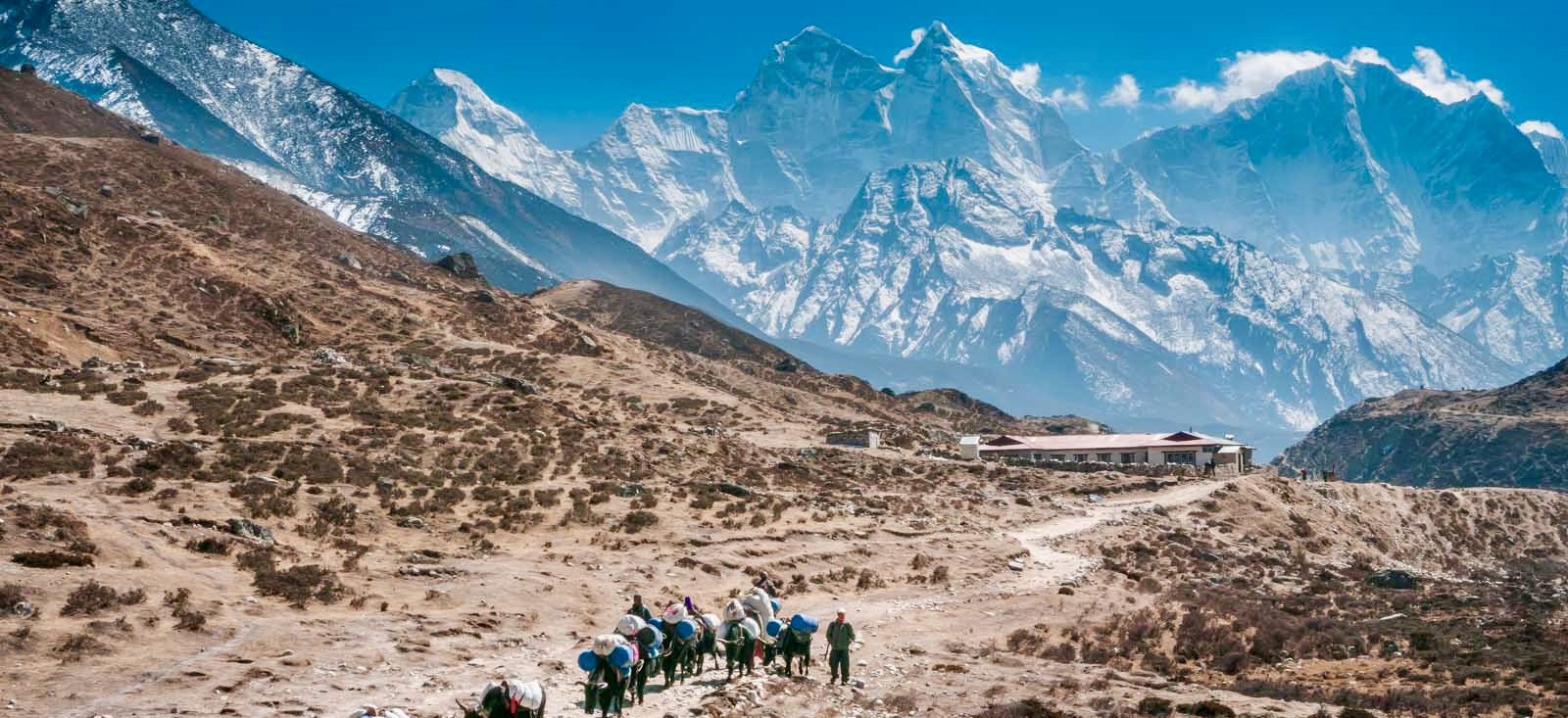
Annapurna Circuit is a classic trek considered to be one of the best trekking experiences on the planet, with some of the most stunning mountain scenery, diverse landscapes, and rich cultural diversity in the world. It can also seem daunting to book this adventure, especially to beginner trekkers, but booking it the correct way is doable, and it’s even kind of fun. From timing your trek to securing permits and booking accommodations, every aspect of the booking process is essential to a hassle-free and unforgettable Himalayan adventure.
The most important and first thing to do is to consider the time you want to start the treatment. The best time to do the Annapurna Circuit is in spring (March to May) and autumn (September to November). During these months, the sky is crystal clear, the temperature is moderate, and the mountains can be seen very clearly, so these months are regarded as the best months for Tibet tours. Once you’ve decided on your dates, it’s important to think about how many days you want to spend on the trek. The complete circuit usually takes 15 to 20 days, but smaller options exist, conditional on the time you have and fitness.
No, that you’ve chosen your dates and your length your trip, the next is whether you want to do the trek on your own or with a guide/agency. It’s arguably more convenient, safer, and culturally enlightening to instead hire a guid, or do a tour. It’s possible to simplify many of your logistics, including transportation and accommodations, as well as the necessary permits, by booking with a reliable trekking agency. It’s a good idea to do a little research online for agencies, read reviews, and compare packages to find one that suits your taste and budget.
Permits are essential for the Annapurna Circuit Trek. The two main things you need to provide are the Annapurna Conservation Area Permit (ACAP) and the Trekkers’ Information Management System (TIMS) card. These are usually taken care of for you if you’re booking through an agency. If you are trekking independently, these permits can be purchased in Kathmandu or Pokhara at the relevant tourism offices. Bring with you passport-sized photos and a photocopy of your passport for the application.
After your permits are organised, the next priority is booking flights and accommodation. Most trekkers travel to, respectively, Besisahar or Pokhara, from where the treks start once land route travel to the Annapurna region is completed. Domestic flights, buses, and jeeps are an option, depending on your route. Domestic travel should be planned, particularly in peak trekking seasons. In the same vein, many teahouses and lodges along the route do not require pre-booking, but booking ahead for popular stops during high season ensures you have a place to stay.
Don’t forget to pack right and don’t neglect travel insurance. The trails can be rough, and the weather erratic — good trekking boots, layered clothing, and appropriate gear are necessary. Adequate insurance for high-altitude trekking and emergency evacuation is also highly recommended.
By arming yourself with the knowledge of each step in the booking process, and getting yourself and your gear in order, your Annapurna Circuit Trek can be an amazing journey full of breathtaking views, warm affects, and a feeling of true achievement. Another couple of weeks later, with or without a group, you will be returning home to a life and a culture which you may never view through those jaded eyes you had sighted the mountain ranges of the Annapurna.
WHEN TO BOOK ANNAPURNA CIRCUIT TREKS FOR THE BEST EXPERIENCE?
The timing of when you book your Annapurna Circuit Trek can have a massive impact. The spring (March to May) and autumn (September to November) are the best trekking seasons. During these months, the weather is very steady, the sky is clear, and the views of the mountains are amazing. Booking three to six months ahead is best, particularly if you intend to go during peak seasons. Advance tourist booking also means better guides, reliable teahouses, and internal transport services. If you are traveling in non-peak months such as monsoon (June to August) or winter (December to February), you can expect less foot traffic, but also less predictable weather. In the off-season, bookings might be easier to arrange later, but logistics should be checked well in advance. Most trekking agents have discounted or special offers during the off-season. Whether in the verdant spring or the cool fall, booking early ensures peace of mind and easier planning. Make sure to verify visa policies, permit requirements, and health information in advance of booking. With time on your side, the Annapurna Circuit becomes more than a trek, it is even a look-at-your-watch-and-mutter-to-yourself “this could not have been a better Himalayan adventure at this very moment”.
Do I Need to Go Through a Trekking Agency or Can I Do the Annapurna Circuit Trek on My Own?
It is possible to organize the Annapurna Circuit Trek yourself, however, both options of booking with or without a trekking agency are entirely up to your trekking experience, budget, and comfort level. Being an independent trekker offers flexibility and saves you money, but you’ll need to manage permits, route planning, accommodation, and your safety. Best for Advanced hikers who know high-altitude travel. On the flipside, if you book through a trekking agent, it takes the hassle off your hands. Organization backing handle permits, accommodation, porters, guides, food, and even emergency planning. Importantly, you enjoy the benefit of local knowledge, linguistic aid, and professional assistance during your entire trip. For first-time trekkers or those visiting during peak seasons, they can also book accommodation in advance, which can be difficult to arrange on your own. Most of the agencies feature both private and group departures, so you can move dates or customize your own. And with an agency, busy hiking times and off-peak months, you know you’re on safe, popular routes. It’s certainly less expensive to book directly, but through an agency, you will have a little more security and reliability. Either route lands you at the same awe-inspiring views, but how you arrive is a matter of training, experience, and planning preferences.
How to Obtain the Permits Required for the Annapurna Circuit Trek?
When trekking the Annapurna Circuit Trek Itinerary, there are two main permits you need: the Annapurna Conservation Area Permit (ACAP) and a Trekkers’ Information Management System (TIMS) card. If you’re trekking with a registered agency, then they will usually take care of these on your behalf. If you are an individual (independent) trekker, you can obtain the permits in Kathmandu or Pokhara at the Nepal Tourism Board (NTB) offices. You will need passport-size photos and a copy of your passport. The ACAP costs NPR 3,000 (approximately USD 25), and the TIMS card is NPR 2,000 for independent trekkers. It is very important to keep both permits on you at all times, as you’ll encounter several checkpoints on the trail. These permits are used to track visitor safety and also fund trail maintenance and conservation. You won’t be able to get them at trailheads — you will need to obtain them before you go out. Do not have any unauthorized vendors to sell you permits. It’s a simple ordeal, of course, but providing that function through an agency makes it much simpler. The lack of permits may lead to fines, or you could be barred from entry at checkpoints, so do not skip this step. It will save you from a lot of hassle and also help towards responsible trekking in the Annapurna area.
What Type of Accommodation Should I Reserve on the Annapurna Circuit?
Lodging on the Annapurna Circuit for the most part are teahouses, locally owned small inns, and restaurants. Most of the year, it is not necessary to book in advance, but during the high trekking seasons (March–May; September–November), popular stops can fill up quickly. The second option is to take a walk, so you do not have to find a place in the high places of the Manang or Thorong Phedi, especially if you are with a group. Rooms are basic — think twin beds and shared toilets, with minimal heating. Wi-Fi, hot showers , and charging outlets might cost extra. Some improved teahouses have private bathrooms, and a tick better amenities. If you`re booking through a trekking agency, then your guide will typically take care of all the bookings for you. Free trekkers can usually find rooms upon arrival, but it’s generally smart to finish destinations early in the afternoon to beat full lodges. Guesthouses in lower-altitude areas are more comfortable, and some have menus featuring various foods. Further up the mountains, lodging is simpler. And wherever you end up, the hospitality of the locals warms your travels. The right accommodation may provide rest, warmth, and food after long days of trekking, and such accommodation also contributes to the local economy.
What Will It Cost to Book the Annapurna Circuit Trek?
Annapurna Circuit Trekking The Annapurna Circuit cost will depend on the company you’re going with. For budget, independent trekkers, it’s possible to do the circuit spending about $20-$30 a day for food, accommodation, permits, and transport. That’s not counting for gear, insurance, or emergencies. The cost for guided treks with a group like this is typically around $800 to $1500 for the all-inclusive 10-18 day package, depending on the level of services, group size, and inclusions. Deluxe packages can run more if you want private guides, porters, domestic flights to or from Nepal, and enhanced accommodations. When you book through an agency, you are covered for most logistics, including permits, accommodation, food, guide or porter wages, and insurance. You will still need to budget extra for snacks, hot showers, Wi-Fi, or renting extra gear. (Insurance with high-altitude rescue is essential and runs around $100, depending on coverage. That can add another $50-200 for a domestic flight or overland transportation, depending on where you are coming from. If it’s tempting to go with the cheapest option, the level and quality of services typically mean better safety and experience.
WHEN TO BOOK ANNAPURNA CIRCUIT TREKS FOR THE BEST EXPERIENCE?
The timing of when you book your Annapurna Circuit Trek can have a massive impact. The spring (March to May) and autumn (September to November) are the best trekking seasons. During these months, the weather is very steady, the sky is clear, and the views of the mountains are amazing. Booking three to six months ahead is best, particularly if you intend to go during peak seasons. Advance tourist booking also means better guides, reliable tea houses, and internal transport services. If you are traveling in non-peak months such as monsoon (June to August) or winter (December to February), you can expect less foot traffic, but also less predictable weather. In the off-season, bookings might be easier to arrange later, but logistics should be checked well in advance. Most trekking agents have discounted or special offers during the off-season. Whether in the verdant spring or the cool fall, booking early ensures peace of mind and easier planning. Make sure to verify visa policies, permit requirements, and health information in advance of booking. With time on your side, the Annapurna Circuit becomes more than a trek, it is even a look-at-your-watch-and-mutter-to-yourself “this could not have been a better Himalayan adventure at this very moment”.
Do I Need to Go Through a Trekking Agency or Can I Do the Annapurna Circuit Trek on My Own?
It is possible to organize the Annapurna Round Trek yourself; however, both options of booking with or without a trekking agency are entirely up to your trekking experience, budget, and comfort level. Being an independent trekker offers flexibility and saves you money, but you’ll need to manage permits, route planning, accommodation, and your safety. Best for Advanced hikers who know high-altitude travel. On the flipside, if you book through a trekking agent, it takes the hassle off your hands. Organization backing handle permits, accommodation, porters, guides, food, and even emergency planning. Importantly, you enjoy the benefit of local knowledge, linguistic aid, and professional assistance during your entire trip. For first-time trekkers or those visiting during peak seasons, they can also book accommodation in advance, which can be difficult to arrange on your own. Most of the agencies feature both private and group departures, so you can move dates or customize your own. And with an agency, busy hiking times and off-peak months, you know you’re on safe, popular routes. It’s certainly less expensive to book directly, but through an agency, you will have a little more security and reliability. Either route lands you at the same awe-inspiring views, but how you arrive is a matter of training, experience, and planning preferences.
How to Obtain the Permits Required for the Annapurna Circuit Trek?
When trekking the Annapurna Trek, there are two main permits you need: the Annapurna Conservation Area Permit (ACAP) and a Trekkers’ Information Management System (TIMS) card. If you’re trekking with a registered agency, then they will usually take care of these on your behalf. If you are an individual (independent) trekker, you can obtain the permits in Kathmandu or Pokhara at the Nepal Tourism Board (NTB) offices. You will need passport-size photos and a copy of your passport. The ACAP costs NPR 3,000 (approximately USD 25), and the TIMS card is NPR 2,000 for independent trekkers. It is very important to keep both permits on you at all times, as you’ll encounter several checkpoints on the trail. These permits are used to track visitor safety and also fund trail maintenance and conservation. You won’t be able to get them at trailheads — you will need to obtain them before you go out. Do not have any unauthorized vendors to sell you permits. It’s a simple ordeal, of course, but providing that function through an agency makes it much simpler. The lack of permits may lead to fines, or you could be barred from entry at checkpoints, so do not skip this step. It will save you from a lot of hassle and also help towards responsible trekking in the Annapurna area.
What Type of Accommodation Should I Reserve on the Annapurna Circuit?
Lodging on the Tilicho Lake Trek for the most part are teahouses, locally owned small inns restaurants. Most of the year, it is not necessary to book in advance, but during the high trekking seasons (March–May; September–November), popular stops can fill up quickly. The second option is to take a walk, so you do not have to find a place in the high places of the Manang or Thorong Phedi, especially if you are with a group. Rooms are basic — think twin beds and shared toilets, with minimal heating. Wi-Fi, hot showers , and charging outlets might cost extra. Some improved teahouses have private bathrooms, and a tick better amenities. If you`re booking through a trekking agency, then your guide will typically take care of all the bookings for you. Free trekkers can usually find rooms upon arrival, but it’s generally smart to finish destinations early in the afternoon to beat full lodges. Guesthouses in lower-altitude areas are more comfortable, and some have menus featuring various foods. Further up the mountains, lodging is simpler. And wherever you end up, the hospitality of the locals warms your travels. The right accommodation may provide rest, warmth, and food after long days of trekking, and such accommodation also contributes to the local economy.
What Will It Cost to Boothe k Annapurna Circuit Trek?
Annapurna Circuit Trek Price The Annapurna Circuit cost will depend on the company you’re going with. For budget, independent trekkers, it’s possible to do the circuit spending about $20-$30 a day for food, accommodation, permits, and transport. That’s not counting for gear, insurance, or emergencies. The cost for guided treks with a group like this is typically around $800 to $1500 for the all-inclusive 10-18 day package, depending on the level of services, group size, and inclusions. Deluxe packages can run more if you want private guides, porters, domestic flights to or from Nepal, and enhanced accommodations. When you book through an agency, you are covered for most logistics, including permits, accommodation, food, guide or porter wages, and insurance. You will still need to budget extra for snacks, hot showers, Wi-Fi, or renting extra gear. (Insurance with high-altitude rescue is essential and runs around $10,0, depending on coverage. That can add another $50-200 for a domestic flight or overland transportation, depending on where you are coming from. If it’s tempting to go with the cheapest option, the level and quality of services typically mean better safety and experience.
How Expensive is a Guide for the Annapurna Circuit?
An Annapurna Circuit guide will generally cost between $25 and $40 per day, depending on the season, experience of the guide, and services included. Prices during high trekking season can be on the steep side due to demand. Some agencies offer package deals that include a guide and porter, as well as permits, accommodation , and meals, and these usually come to between $800 and $1,500 for the entire trek. A guide doesn’t just guide but also provides security, assists with culture, and manages the logistics. Hiring a guide is an added cost, but many trekkers spend the money in order to avoid the crowded trails and for peace of mind and a more rewarding experience.
Do I need a guide for the Annapurna Circuit?
You don’t have to do the Annapurna Circuit Nepal. The Annapurna Circuit is well signed, becoming more popular with independent trekkers and no longer strictly requires a guide. A guide is recommended but not obligatory, particularly for novice trekkers or those with limited experience of high altitude. Guides offer invaluable help with route finding, acclimatisation, local customs, and emergencies. They also help arrange lodging and permits. But for people who want a hassle-free trek and a little extra safety, splurging on a guide adds a lot of value to the experience. It is technically possible for experienced, prepared solo trekkers to make it around the circuit by themselves, but they should really think about how comfortable and safe they feel.
Is It Possible to Complete the Annapurna Circuit Trek Without a Guide?
Yes, you can certainly trek the Annapurna Circuit independently, and that is what we recommend. If you are trekking independently, you need to plan permits (ACAP & TIMS), the route, accommodation, and risks of Altitude Sickness, etc. You must be self-sufficient and able to travel in a confident manner and be physically fit. Independent treks provide more flexibility and can cost less, but they take planning and back-up precautions for safety. If you love the freedom of adventure and have some experience trekking, solo trekking through the Annapurna Circuit is completely possible.
Is the Annapurna Circuit Trek Suitable for Beginners?
It is possible to hike the Annapurna Circuit as a beginner, but the hiker should be thoroughly prepared. The trek traverses mixed terrain and high elevations, including the strenuous Thorong La Pass at 5,416 meters (17,769 feet). Beginners should schedule additional days for acclimatization to the altitude and might want to hire a guide or go in a group for added assistance. Both fitness and endurance are key, so if you can, get training in before the trek. With the right preparation, taking it slowly and watching attentively for symptoms of altitude sickness, novices can safely experience the amazing scenery and cultural mosaic of the Annapurna Circuit. If you’ve never been on a trek, do shorter or rather lower-altitude treks.





